| URLs in this document have been updated. Links enclosed in {curly brackets} have been changed. If a replacement link was located, the new URL was added and the link is active; if a new site could not be identified, the broken link was removed. |
Tips from the Experts
RSS Feeds from STM Databases: Innovative Possibilities
Science Librarian
Steacie Science & Engineering Library
York University Libraries
Toronto, Ontario
rajivn@yorku.ca
Abstract
Really Simple Syndication (RSS) feeds have been used in academic libraries to follow new information posted on blogs, wikis and web sites. Science, Technology and Medicine (STM) databases also offer RSS feeds which can be used by science librarians to track research being conducted in their subject areas. The knowledge gained from these constantly updated sources can help in collection development activities. RSS feeds can also be used to highlight grant-funded research and monitor trends in Open Access publishing. This article documents some unique ways of using RSS feeds from STM databases.
Introduction
RSS is an acronym for Really Simple Syndication or Rich Site Summary, where syndication distributes content of all types throughout the Web to patrons who wish to receive that content after they have specifically "subscribed" to "feeds" of interest. RSS uses an XML-based format for content distribution and to constantly scan the content of web sites for their latest updates, including, for example, news headlines, events, journal tables of contents, database searches, blogs, or audio and video files. These updates are then automatically delivered to the subscriber's computer or handheld device through an RSS feed. RSS feeds provide short summaries of the sources or web sites to which the user has subscribed. These short listings may contain metadata such as a title and a hyperlinked title which offers the user an opportunity to read the entire content on the parent web site.
Few papers have been published that actually demonstrate how RSS feeds are being used to help graduate students, faculty members, and research officers in knowledge gathering activities. RSS feeds can help in selective dissemination of research information and can promote the usage of STM databases within our academic community. In this paper, I will highlight some examples of using RSS feeds from STM databases and how this technology tool can be used innovatively.
Health sciences liaison librarians at the University of South Dakota (USD) teach students, staff, and faculty to use RSS feeds, thereby helping them obtain, track, and organize information effectively. Liaison librarians at USD have used RSS to post updated web content to their online course guides (De Jager-Loftus 2009). RSS also allows for instructors to match the level of the information in the feeds to the educational level of the students in a given class. Librarians at Purdue University have created an information portal using RSS feeds from journal databases (Kolah & Fosmire 2010). RSS feeds can also be embedded into web pages, both within the library web site and on pages outside of the library. Once set up, headlines appear in those pages and are updated as new stories are added, without any additional coding. RSS feeds were created for a special library in Saskatchewan, Canada for ten subjects in the sciences and the blogroll was promoted to library staff. The RSS feed-based current awareness system was incorporated into new employees' library orientation, and orientation sessions for existing employees were held as their schedules allowed (Neilson 2008). Though the uptake of RSS feeds by library staff was not exceptional the author found RSS feeds to be an important tool for identifying pertinent new material. A few staff members indicated that they tended to forget about the blogs and feeds and were unlikely to seek out the current awareness posts even though they found it useful. Though the author was using PubMed and EBSCO automated searches as a tool for self-awareness it is not evident if RSS feeds from databases were promoted to faculty and students.
RSS Feeds in Academic Libraries: Some Possibilities
Biomedical databases have implemented RSS services which can be used as an effective means of disseminating research information within and outside the academic environment (Figure 1). Search queries can be formulated in databases including PubMed, Web of Science (WoS), and Scopus and users can subscribe to RSS feeds. This allows patrons to follow the most recent articles indexed in the databases from one central location without inundating their e-mail inbox. Other possibilities of using RSS feeds in the academic environment are also explored (Figure 1).
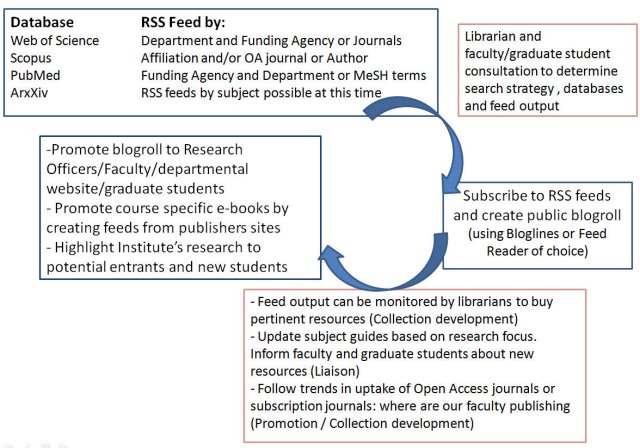
Figure 1: RSS Feeds from STM databases -- Exploring Possibilities
The research process today is no longer likely to begin with a face-to-face consultation with a librarian, a visit to the library's special collections service points, or a search of the online library catalog. Rather, faculty most often turn to network-level services, including both general purpose search engines and services targeted specifically to academia (Schonfeld and Housewright 2009). Providing target specific information from STM databases may be of use to faculty members, graduate students, and research officers who are interested in compiling departmental and/or subject research. Librarians have an important role in creating information portals using RSS feeds from STM databases since they are aware of the unique strengths and coverage of these databases. They can also suggest additional plug-ins so that patrons viewing the feeds from off-campus locations have seamless access to subscribed content. Feed results can also help librarians to identify publication trends and help them in their collection development activities.
Web of Science & RSS Feeds
In order to obtain and subscribe to the RSS feeds using Web of Science:
- Conduct a search in Web of Science (Figure 2)
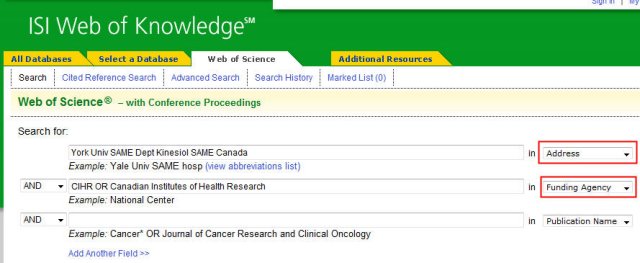
Figure 2: Address & Funding Agency fields in Web of Science
Funding Agency and Address search fields in Web of Science (WoS) database allows users to limit results to papers that have included research grant information. For example, searching York Univ SAME Dept Kinesiol SAME Canada and CIHR OR Canadian Institutes of Health Research in the "Funding Agency" can be used to highlight papers from researchers affiliated with York University from Kinesiology and Health Science who have acknowledged CIHR funding. Librarians and research officers can create RSS feeds for these results and keep abreast of the latest inclusions. Feeds can also be created for specific Open Access journals and combined with Affiliation searching.
- Click on Search History tab to save history
- Select Save History in WoS to obtain RSS feed (Figure 3)
- Users will be prompted to open a free account in Web of Science
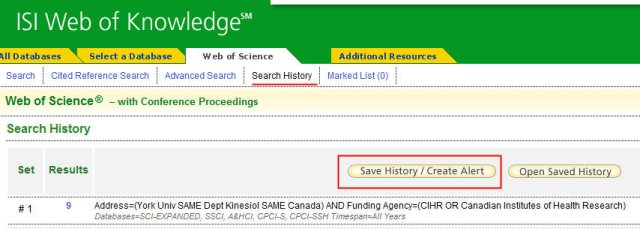
Figure 3: Save History in Web of Science to obtain RSS feeds
- Sign-in to your personal account in Web of Science
- Firefox users can click on the orange XML icon and subscribe to RSS feeds using a web based feed reader (Figure 4) like Bloglines.
The author chose Bloglines as the RSS feed reader since it offers a cleaner interface and is relatively easy to use. There are many other free feed readers including Google Reader and Netvibes and users can also follow content indexed in STM databases using browser-based readers.

Figure 4: RSS Feed for research papers from Kinesiology Department at York University
First-time users will be prompted for the log-in to their Bloglines account before they can subscribe to the WoS feed. Librarians can monitor the unread/new articles indexed in the feed output which is indicated by the bolded feed title; for example, there are three unread articles in CIHR_YU_Web_Sci (Figure 5).
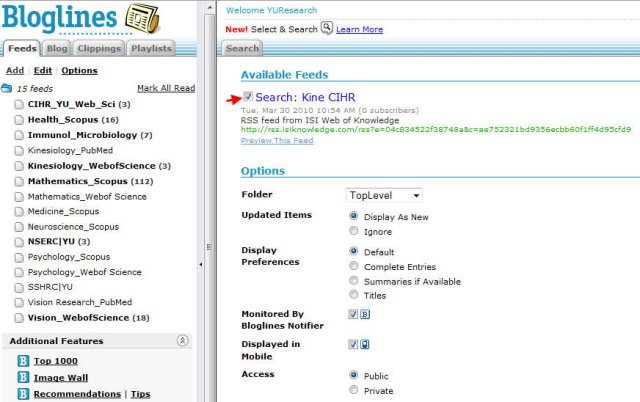
Figure 5: Subscribing to a RSS feed using Bloglines
Account holders can rename or delete a feed using the Edit tab in Bloglines. They can also subscribe to other feeds from the Add tab. Librarians setting up RSS feeds should include all abbreviated forms of the institution(s) and the funding agency(ies) so as to include all papers; for example, including York Univ SAME Toronto in the Address field instead of York Univ SAME Canada results in retrieval of a smaller number of records. Similarly the abbreviation for University of British Columbia in Web of Science is Univ British Columbia and not UBC. Using Institution Affiliation/Address is more reliable than Author field when creating feeds since not all articles' authors assign the proper Thomson Reuters abbreviation.
PubMed & RSS Feeds
Librarians can create RSS feeds from searches conducted in PubMed database. Searches can be simple keyword searches or can include MeSH (Medical Subject Heading) terms and/or funding agencies. In order to subscribe to RSS feeds from PubMed:
- Conduct your search in PubMed
- Click on RSS icon and subsequently on the orange XML icon to subscribe (Figure 6).
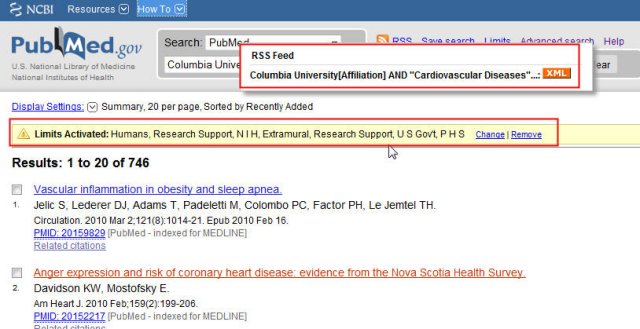
Figure 6: RSS feeds for Columbia University[Affiliation] AND "Cardiovascular Diseases"[Majr] that have received NIH or PHS funding
- Track new articles indexed in PubMed using Bloglines Reader
PubMed RSS feeds can be used to follow research papers from Open Access journals that do not offer Affiliation searching. The output can be used by Research Officers or Librarians conducting trend analysis of publications in Open Access journals at their universities.
The author has conducted detailed searches in PubMed in consultation with graduate students. Students can subscribe or view the RSS feeds of new articles indexed in STM databases from this blogroll (list of RSS feeds). Off-campus students need to install a browser plug-in like LibX to access complete articles after EZProxy authentication (Figure 7).
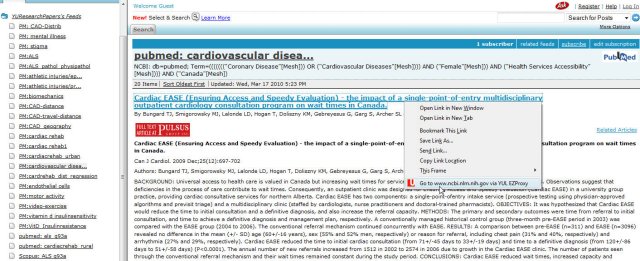
Figure 7: RSS feeds on topics of interest to graduate students
When recommending RSS feeds for students, accessibility and reading level are both important. Students are more likely to read an article if the full text is available on their computers or if the full-text search options can be seamlessly integrated with RSS results in Bloglines. On-campus users can click on the titles indexed in the blogroll they are directed to the article within the database. If off-campus users want to access the blogroll content (full text), they need to open another browser and access the article from the STM database. This circuitous route can be avoided by installing a customized LibX plug-in which allows authentication and access to the article from the blogroll (Figure 7).
LibX is a browser plug-in for Firefox and Internet Explorer that provides direct access to a library's resources. Currently, 752 academic and public libraries have created public LibX editions. We inform students and faculty about the benefits of LibX at graduate open houses and have had 660 downloads since last year.
Scopus & RSS Feeds
Affiliation Search in Scopus can be used to highlight research papers from a particular institution (Figure 8). The database has clearly demarcated Author profiles listing all their publications. RSS feeds can be created for individual authors which can be posted on Author web sites.

Figure 8: RSS feeds for research articles in Neuroscience from a specific University
In order to subscribe to Scopus feeds:
- Conduct an {Affiliation search} in Scopus
- Click on RSS icon displayed besides the results to subscribe to RSS feeds using Bloglines
Faculty in Mathematics & Statistics and Physics had asked us to create university-specific feeds for ArXiv. Scopus indexes content from ArXiv but these results cannot be combined with Affiliation searching. It is not possible to subscribe to RSS feeds for individual departments/schools since department fields are not available at present. Scopus RSS feeds for Affiliation search can be displayed on a university's web site. Users can create a personal account in Scopus and obtain HTML feed that can be used to highlight recent publications from their university (e.g. YORKwrites). This can give potential graduate students an indication about the research output of our university and may help them in the application process. Kolah and Fosmire (2010) describe the steps for creating RSS and HTML feeds from Scopus database which have been used to highlight a faculty member's publications on his web site at Purdue University.
Creating a Public Blogroll in Bloglines
As new papers matching our search criteria are indexed in STM databases they are populated in Bloglines blogroll (list of blogs/RSS feeds). This blogroll can be made public so that it is accessible to all. Account holders need to click on Account and select Blog settings. They can provide a unique name for the blog and then select Yes, publish my Blogroll (Figure 9).
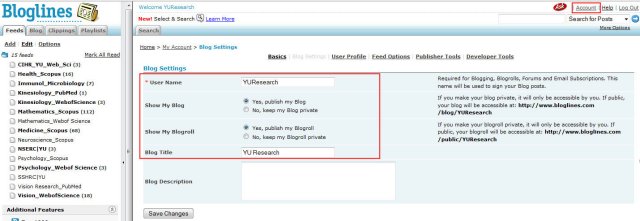
Figure 9: Creating a public Blogroll
The URL of the blogroll is http://www.bloglines.com/public/User Name (e.g., http://www.bloglines.com/public/YUResearch).
Promotional Activities
The YUResearch blogroll (Figure 10) was promoted at faculty and graduate students' orientations and the link was sent to Faculty of Health Research Officers and faculty members in concerned departments.
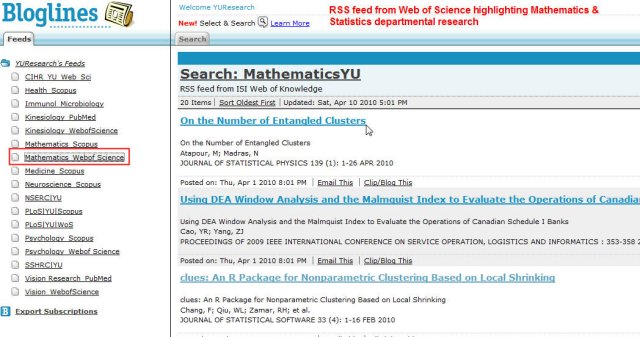
Figure 10: Blogroll of RSS feeds from different STM databases
Faculty members commented that the RSS application was useful as a departmental research output tool. It was posted by the Neuroscience department on their web site (Figure 11).
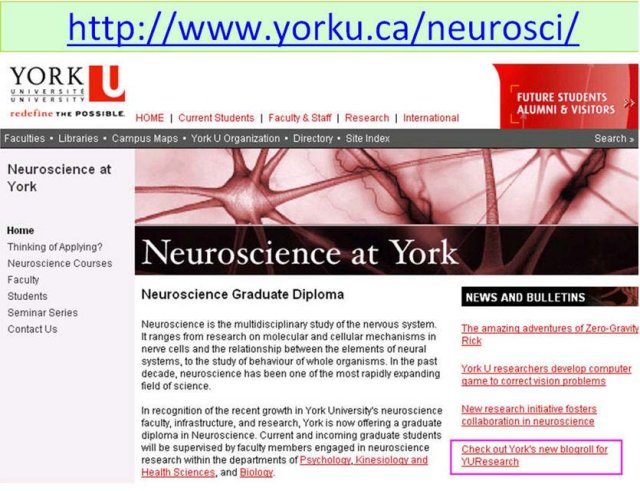
Figure 11: Promotion of YUResearch Blogroll by Neuroscience department
Graduate students use the YUResearchPapers to find MeSH terms in PubMed and to browse new papers indexed in Scopus. Though students have not subscribed to the blogroll, it has been bookmarked (personal communications with the author). Faculty members do not subscribe to OPML feeds from Bloglines but use the YUResearch blogroll as a current awareness tool for departmental research (personal communication). The blogroll could be further promoted by providing the most relevant HTML feeds to faculty members so that it can be posted on their web sites.
We have also created an open blogroll of e-books consisting of RSS feeds from Springer e-books, Synthesis Engineering e-books and subject specific e-books from our VuFind library catalogue. RSS feeds from different sources can be embedded in course pages, reading lists, new books blog or on relevant subject guides. The headlines on the home page of the Barker Engineering Library at MIT were created using the "engineering" RSS feed from the main MIT Libraries News blog (Duke et al. 2006). The authors further state that once created the RSS feeds are free from formatting and can be reused in different ways.
Conclusion
Librarians need to constantly explore how technology tools can be used to understand research facets at their university. We have used Bloglines and created blogrolls of customized searches from STM databases. They are being used to highlight departmental research, to promote publications of York Authors in Open Access journals including papers stemming from {grant funded research}. These papers can then be included in our institutional repository as per requirements of funding agencies. The feeds help us to highlight subject based papers, new e-books in our collection and assist graduate students to identify new papers indexed in these databases.
There are many other innovative possibilities for using this technology tool and the paper has touched on some examples. Data gathered from RSS feeds can be analyzed periodically and librarians can use it to supplement their decisions when they are canceling or procuring new journals. Librarians can use the new features provided by STM databases to highlight the university's research, build professional connections with faculty members and graduate students and consequently increase the librarian's profile at the university. New search fields in STM databases can be combined with the power of RSS feeds to serve the information needs of a broad section of the academic community. This can also help librarians in the promotion and usage of STM databases on their campuses.
References
De Jager-Loftus, D. 2009. Value-added technologies for liaison and outreach. Journal of Electronic Resources in Medical Libraries 6(4): 307-315.
Duke, D. J., Hartman, S., & Locknar A. 2006. Reaching the engineering and science communities: new technologies and approaches at MIT. Issues in Science and Technology Librarianship [Internet]. [Cited January 17, 2010]; 45. Available from: http://www.istl.org/06-winter/article1.html
Kolah, D. & Fosmire, M. 2010. Information portals: a new tool for teaching information literacy skills. Issues in Science and Technology Librarianship [Internet]. [Cited February 2, 2010]; 60. Available from: http://www.istl.org/10-winter/refereed1.html
Neilson, C. 2008. Current awareness on a shoe string: RSS at the HQC. Internet Reference Services Quarterly 13(1): 57-67.
Schonfeld, R. C. & Housewright R. 2010. Faculty Survey 2009: Key Strategic Insights for Libraries, Publishers, and Societies. [Internet]. [Cited April 12, 2010]. Available from: {http://www.sr.ithaka.org/wp-content/uploads/2015/08/Faculty_Study_2009.pdf}
| Previous | Contents | Next |
